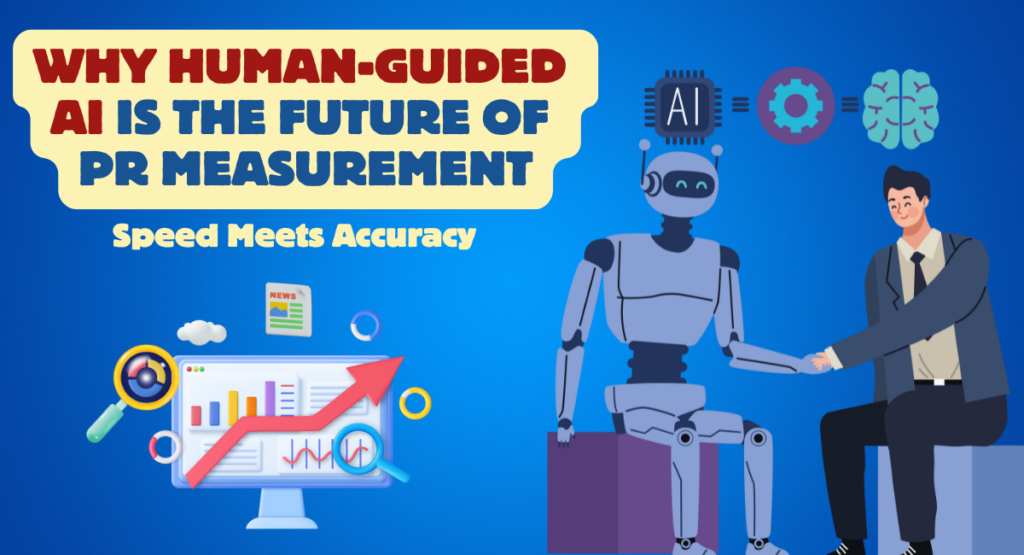Human-in-the-Loop Technology: Why It’s Essential for Modern PR

Credible predictive PR metrics are finally available, necessitating the need for hybrid media intelligence.
The problem with PR measurement isn’t that there aren’t good metrics or that there isn’t enough science validating what those metrics can predict. Evaluating media at the depth required has been a challenge to automate. Consider this: in some cases, predictive PR measurement requires more than 90 different data signals to be coded to a single article, social media shares, brand-level sentiment, voices, and visuals. Understanding your brand is worth it, knowing with certainty what messages increase brand value and which put it at risk, but it takes time.
The answer has been various levels of automation, sacrificing accuracy and depth for speed. The challenge is that accuracy in media monitoring of this type is crucial; the little things matter. PR professionals and enterprises need dynamic search ability and the quick application of these more advanced metrics to issues occurring in real time.
The Role of Human Judgment in Media Intelligence
Humans can ingest way more information than we give ourselves credit for. Analysts understand a customer’s intentions, are guided by ethics, and read between the lines of the search requirements. That moral sense helps them understand an article’s impact in addition to experience and data. Most automated approaches miss the nuance of understanding whether a voice in an article is trusted by the audience, for example.
With new AI tools and humans-in-the-loop, or HILT, processes, the Institute for Public Relations has suggested that it is possible and likely the way forward. Human analysts can now supervise the tagging and coding processes that machines are conducting. With programmatic methods, we can reduce false positives and evaluate brand-level sentiment.
Internal analyses and external data, like Gartner’s recent analysis, show that HILT improves accuracy and trust in PR reporting tools while speeding up the process of delivering predictive and actionable insights.
Common Pitfalls of Pure Automation
Automation alone has its barriers. Without a human sample to compare accuracy against, it is difficult to say whether an insight and the data behind it can stand up. The risk of getting a brand-defining question wrong because of improper application of PR measurement science is real.
Automation or black-box AI solutions that transmogrify media data into insights without human supervision increase those risks. Just consider the algorithmic errors in the nuance of medical and pharmaceutical news; stories about cancer are often noted as negative. Missing context is missing everything.
Building the Right Human+AI Workflow
The crucial point of HILT is that when critical decisions are made, you need to know that someone has double-checked the data. We oversample negative coverage, for example, to be aware of the critical voices. This enhances our accuracy and aids in how we train our AI.
As these functions evolve and the learning models behind them become more sophisticated, so will our ability to provide feedback loops back to humans. Also, give them the chance to pull a fire alarm and stop the press. The best chance you have at delivering speed and accuracy for high-stakes brand decision-making is with HILT.
True media insight doesn’t come from speed alone—it comes from understanding. While AI can process at scale, it’s the human touch that brings depth, context, and credibility to the data. Human-in-the-loop systems aren’t just a stopgap for AI limitations; they’re a blueprint for better decision-making. In a world where nuance defines reputation, blending machine efficiency with human judgment isn’t just the future of PR measurement—it’s the standard it should be held to.
James Rubec
James Rubec is the Head of Product at Fullintel, specializing in PR analytics and media intelligence. With more than 15 years of experience at the intersection of public relations, digital media, and crisis communication, he has advised global brands on navigating complex social media landscapes and reputation management strategies. His profound expertise in social sentiment analytics, predictive analytics, and actionable media insights uniquely positions him to guide PR professionals through the evolving challenges of digital media monitoring.
James Rubec is the Head of Product at Fullintel, where he leads the development of cutting-edge media monitoring and analysis tools tailored for PR and communications professionals. With a deep background in media intelligence, analytics, and AI-driven insights, James specializes in transforming vast amounts of media data into actionable intelligence for Fortune 500 companies, government organizations, and top-tier agencies. His expertise spans media measurement, sentiment analysis, and the strategic application of AI to enhance PR decision-making. Under his leadership, Fullintel has pioneered innovations in AI-powered media monitoring, crisis detection, and competitive benchmarking, ensuring clients stay ahead in an increasingly complex media landscape.




